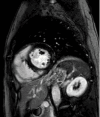The Clinical and Histological Intersection of Cardiac Sarcoidosis and Giant Cell Myocarditis
- PMID: 38846240
- PMCID: PMC11154654
- DOI: 10.7759/cureus.59783
The Clinical and Histological Intersection of Cardiac Sarcoidosis and Giant Cell Myocarditis
Abstract
The clinical and imaging features of cardiac sarcoidosis (CS) and giant cell myocarditis (GCM) are occasionally indistinguishable. This is a case of heart block and ventricular tachycardia where cardiac MRI, fluorodeoxyglucose positron emission tomography (FDG-PET) and biopsy revealed intermediate clinicohistologic phenotype between CS and GCM. This highlights gaps in the management of overlap conditions.
Keywords: biopsy; cardiac sarcoidosis; giant cell myocarditis; histology; management; overlap; pet scans.
Copyright © 2024, Sharma et al.
Conflict of interest statement
The authors have declared that no competing interests exist.
Figures




Similar articles
-
Fulminant cardiac sarcoidosis resembling giant cell myocarditis: a case report.Eur Heart J Case Rep. 2021 Mar 10;5(3):ytab042. doi: 10.1093/ehjcr/ytab042. eCollection 2021 Mar. Eur Heart J Case Rep. 2021. PMID: 33733047 Free PMC article.
-
Giant Cell Myocarditis vs Cardiac Sarcoidosis: Reconsidering the Diagnosis With FDG PET Imaging.JACC Case Rep. 2024 Nov 20;29(22):102738. doi: 10.1016/j.jaccas.2024.102738. eCollection 2024 Nov 20. JACC Case Rep. 2024. PMID: 39691891 Free PMC article.
-
Cardiac sarcoidosis and giant cell myocarditis as causes of atrioventricular block in young and middle-aged adults.Circ Arrhythm Electrophysiol. 2011 Jun;4(3):303-9. doi: 10.1161/CIRCEP.110.959254. Epub 2011 Mar 22. Circ Arrhythm Electrophysiol. 2011. PMID: 21427276
-
Idiopathic giant cell myocarditis and cardiac sarcoidosis.Heart Fail Rev. 2013 Nov;18(6):733-46. doi: 10.1007/s10741-012-9358-3. Heart Fail Rev. 2013. PMID: 23111533 Review.
-
[Inflammatory heart diseases--cardiac sarcoidosis and giant cell myocarditis].Duodecim. 2015;131(22):2127-33. Duodecim. 2015. PMID: 26749906 Review. Finnish.
References
-
- Underlying causes and long-term survival in patients with initially unexplained cardiomyopathy. Felker GM, Thompson RE, Hare JM, et al. N Engl J Med. 2000;342:1077–1084. - PubMed
-
- A clinical and histopathologic comparison of cardiac sarcoidosis and idiopathic giant cell myocarditis. Okura Y, Dec GW, Hare JM, et al. J Am Coll Cardiol. 2003;15:322–329. - PubMed
-
- Heart Failure Association, Heart Failure Society of America, and Japanese Heart Failure Society Position Statement on Endomyocardial Biopsy. Seferović PM, Tsutsui H, Mcnamara DM, et al. J Card Fail. 2021;27:727–743. - PubMed
Publication types
LinkOut - more resources
Full Text Sources
